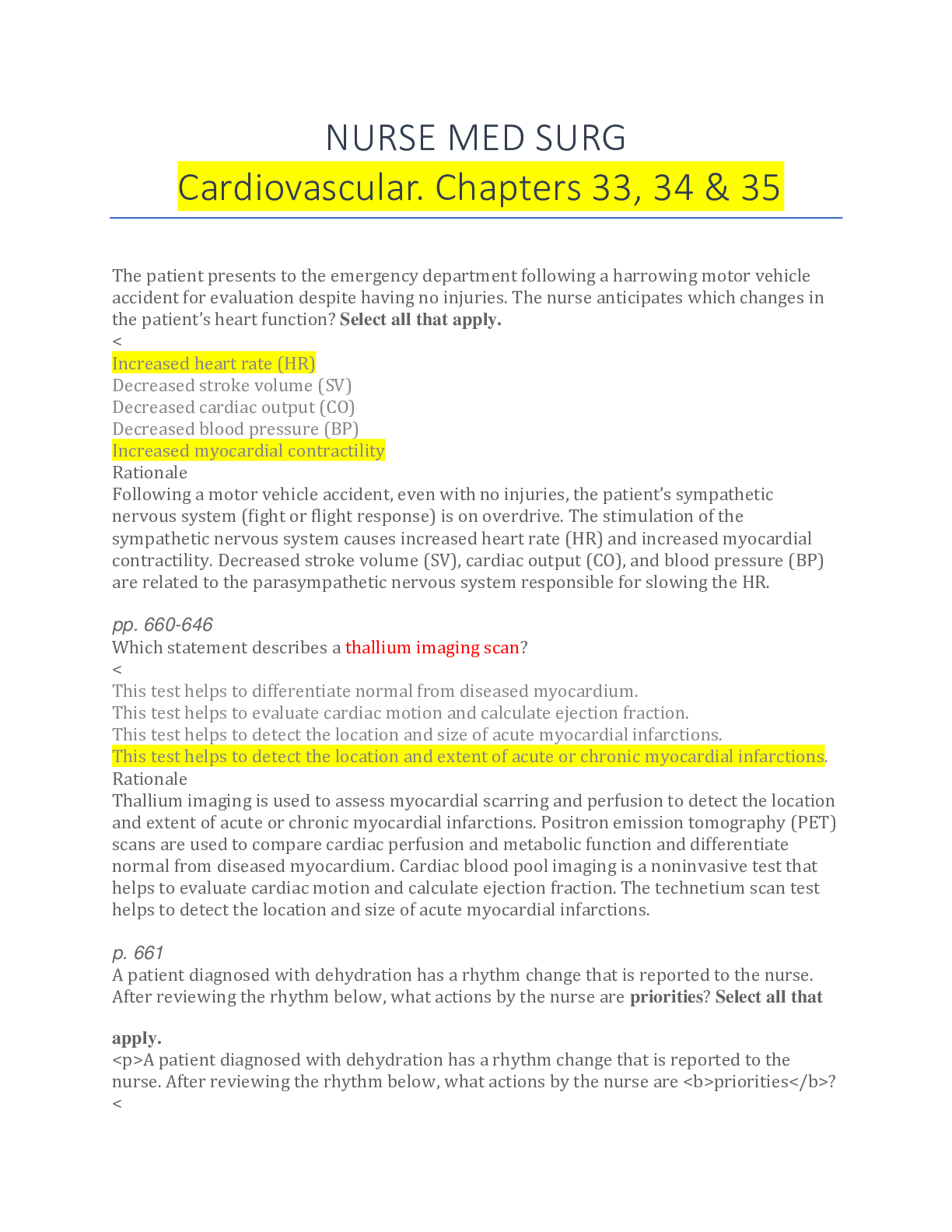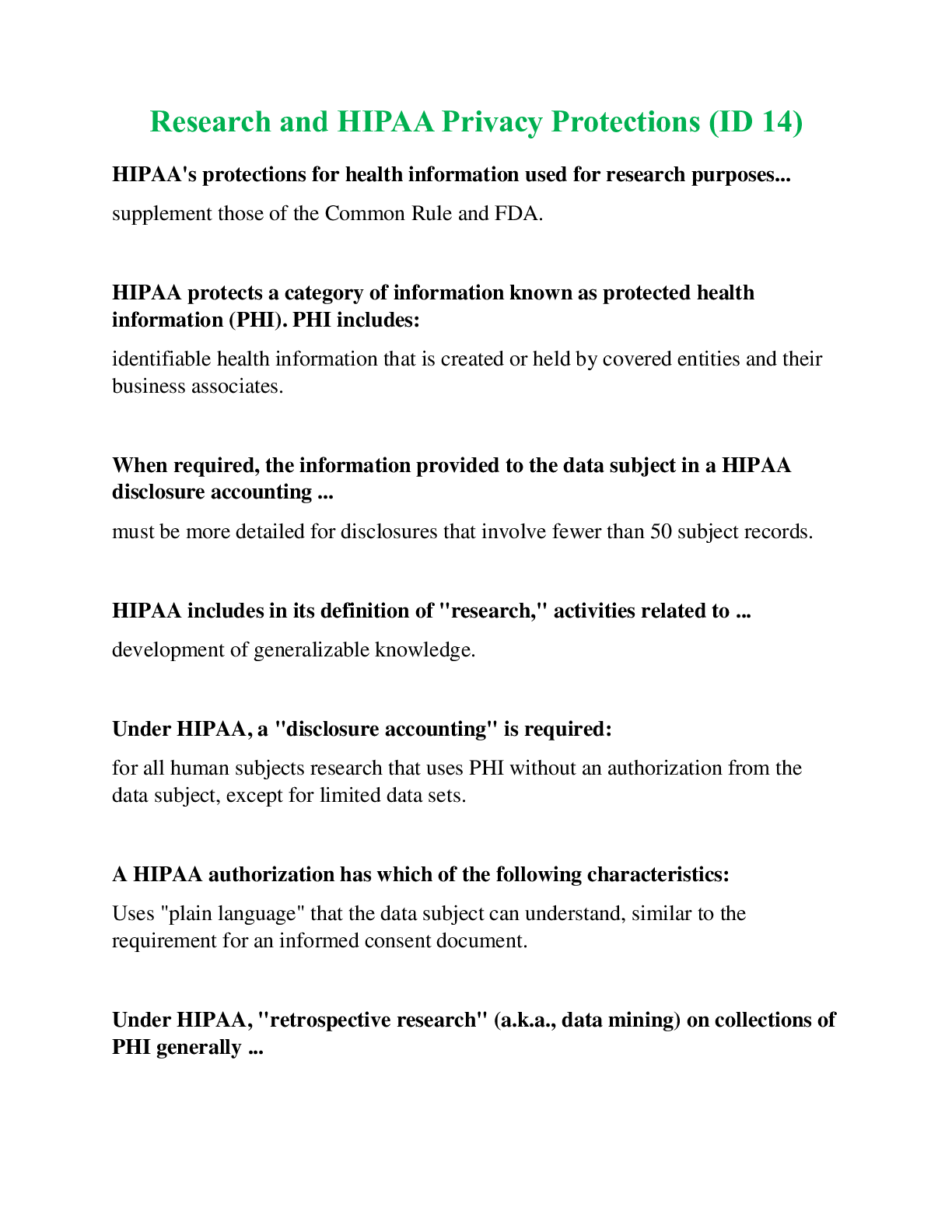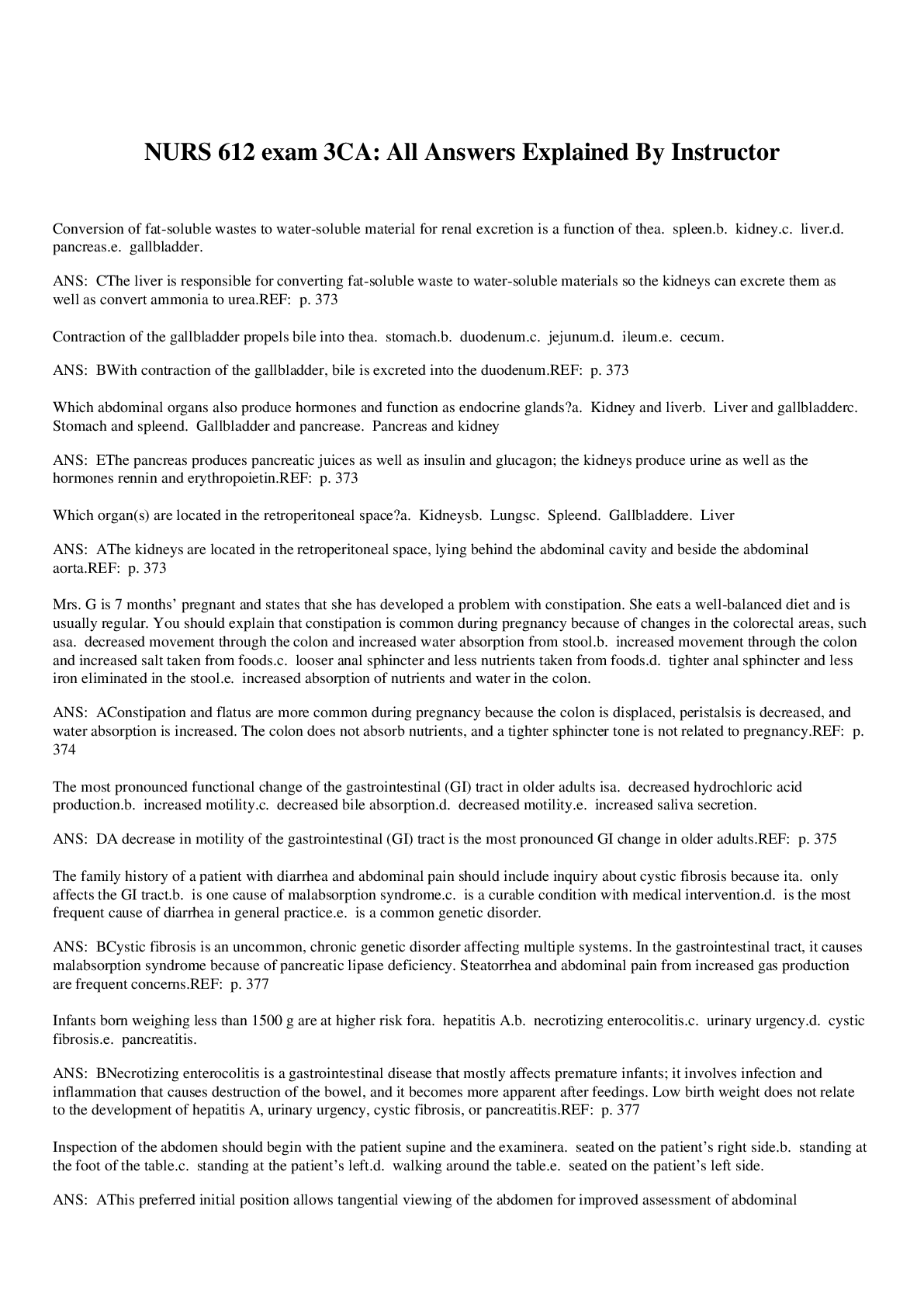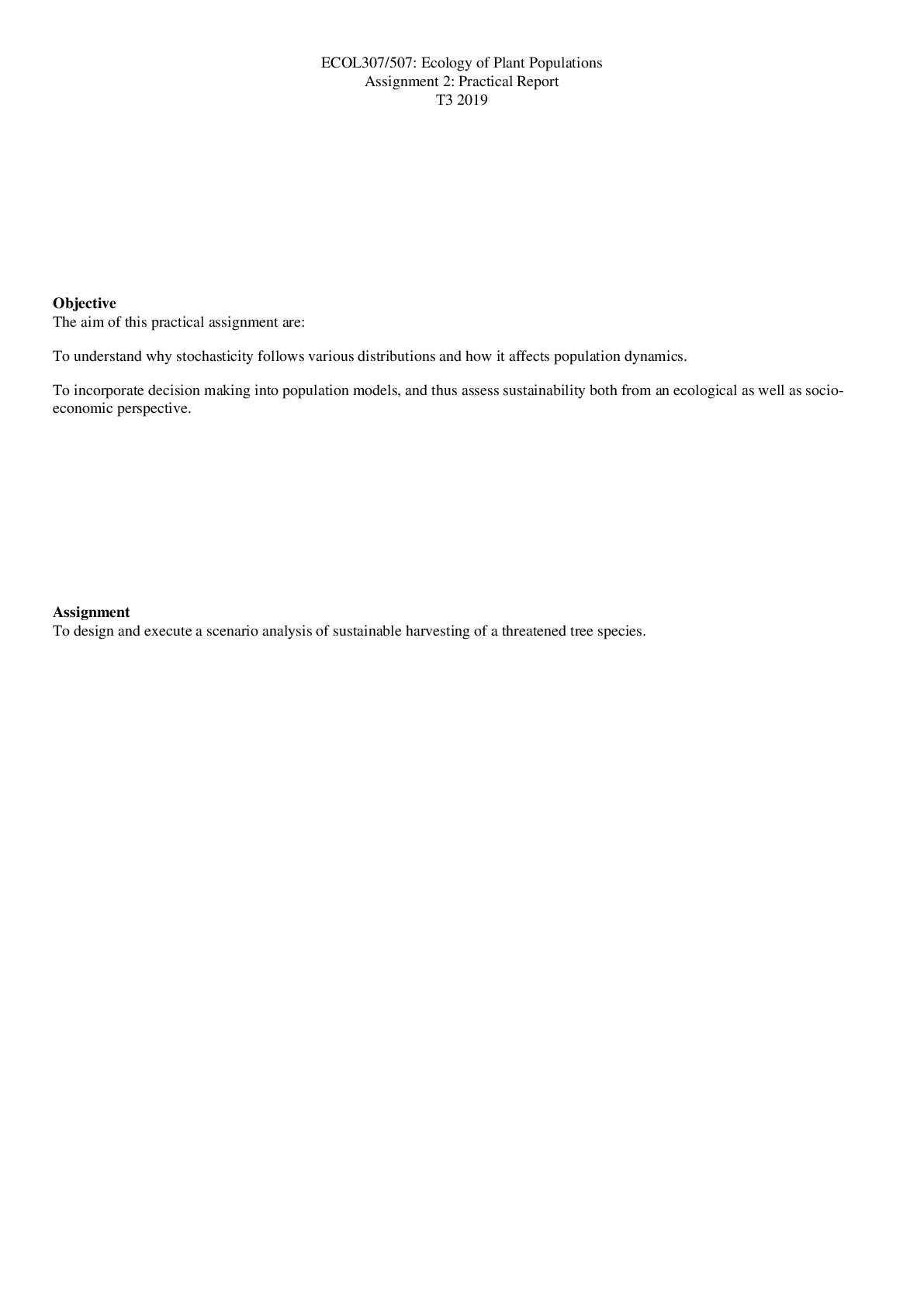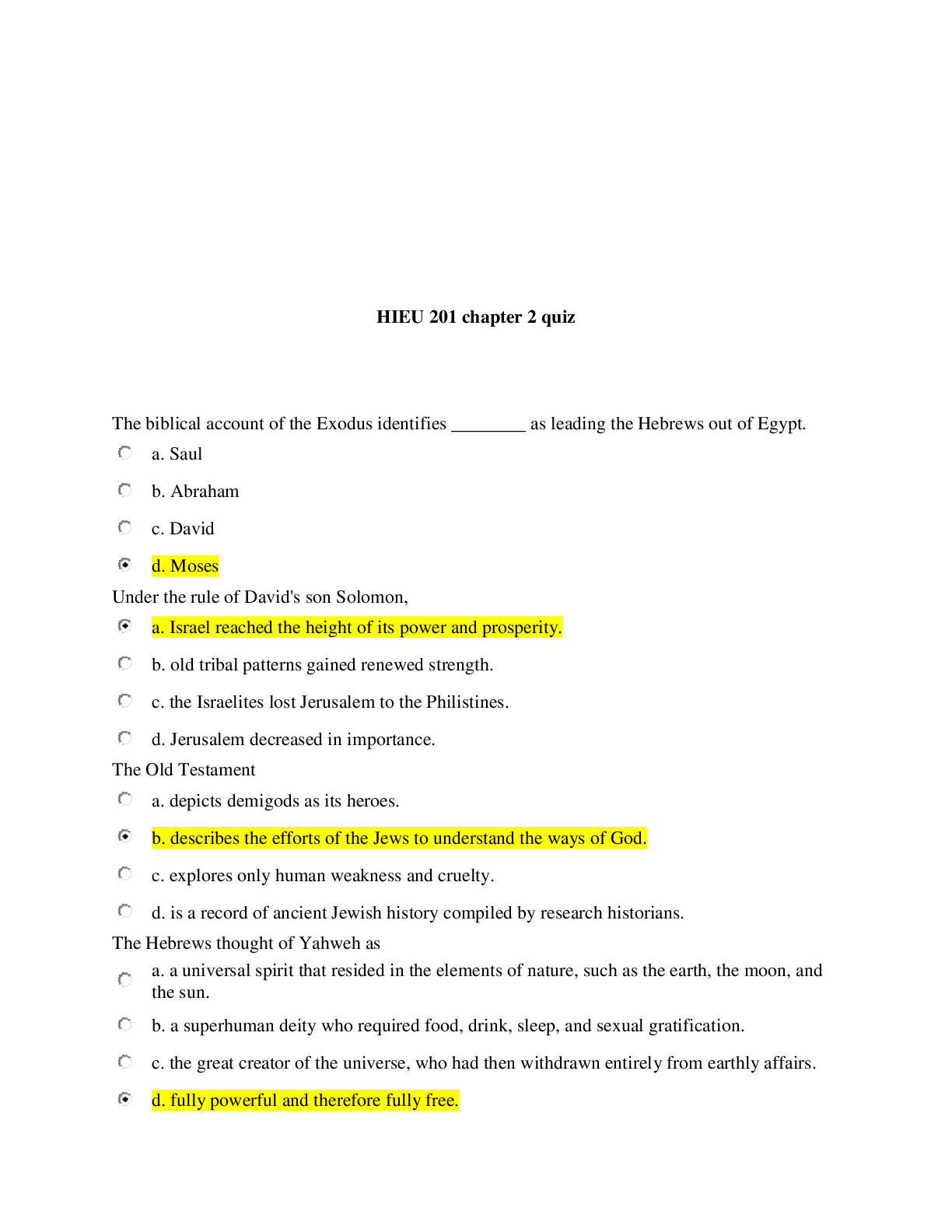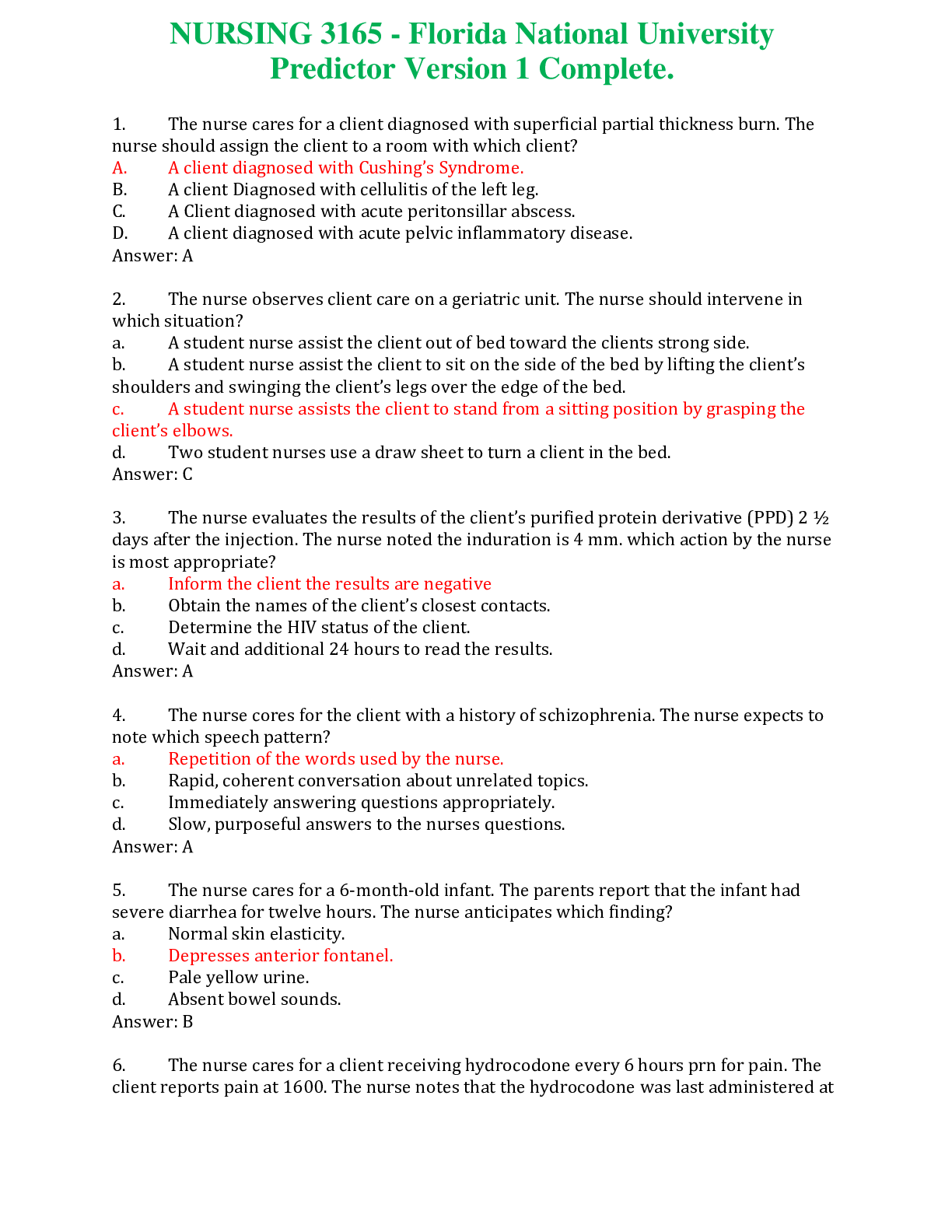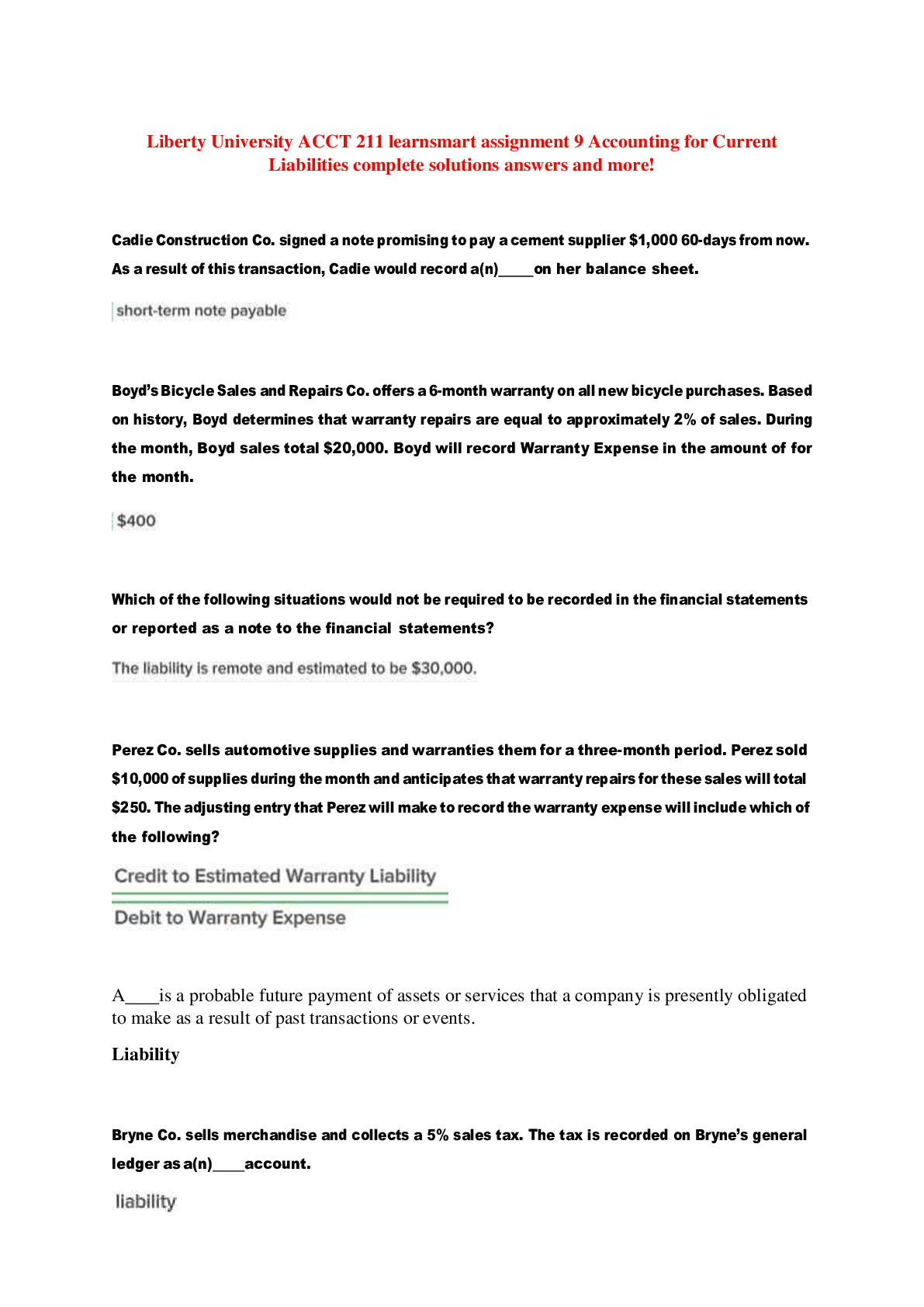Biological Psychology > QUESTIONS & ANSWERS > Chapter_11_Emotional_Behaviors: Questions and Answers (All)
Chapter_11_Emotional_Behaviors: Questions and Answers
Document Content and Description Below
1. Psychologists typically define emotion in terms of three components. a. b. False : DIFFICULTY: Bloom’s: Understand REFERENCES: Introduction LEARNING OBJECTIVES: KALA.BIOP.16... .11.01 - Discuss the role of the autonomic nervous system in emotional feelings. TOPICS: 11.1 What is Emotion? 2. According to the James-Lange theory of emotion, we experience physiological changes first and then label these changes as an emotion. a. b. False : DIFFICULTY: Bloom’s: Understand REFERENCES: Emotions and Autonomic Arousal LEARNING OBJECTIVES: KALA.BIOP.16.11.01 - Discuss the role of the autonomic nervous system in emotional feelings. TOPICS: 11.1 What is Emotion? 3. The pattern of physiological reactions for each emotion is easily distinguishable by the person who is experiencing them. a. b. False : False DIFFICULTY: Bloom’s: Understand REFERENCES: Emotions and Autonomic Arousal LEARNING OBJECTIVES: KALA.BIOP.16.11.01 - Discuss the role of the autonomic nervous system in emotional feelings. TOPICS: 11.1 What is Emotion? 4. The more important contributions to emotions come from the effects of the autonomic nervous system, not muscle activity. a. b. False : DIFFICULTY: Bloom’s: Understand REFERENCES: Emotions and Autonomic Arousal LEARNING OBJECTIVES: KALA.BIOP.16.11.01 - Discuss the role of the autonomic nervous system in emotional feelings. TOPICS: 11.1 What is Emotion? 5. People with damage to either the prefrontal cortex or the amygdala show difficulties processing emotional information. a. b. False : DIFFICULTY: Bloom’s: Understand REFERENCES: The Functions of Emotions LEARNING OBJECTIVES: KALA.BIOP.16.11.05 - Discuss the role of the amygdala in emotional processing. TOPICS: 11.1 What is Emotion? 6. The limbic system—the forebrain areas surrounding the thalamus—has been regarded as non-critical for emotion. a. b. False : False DIFFICULTY: Bloom’s: Understand REFERENCES: Emotions and Autonomic Arousal LEARNING OBJECTIVES: KALA.BIOP.16.11.01 - Discuss the role of the autonomic nervous system in emotional feelings. TOPICS: 11.1 What is Emotion? 7. Low serotonin turnover is associated with reduced aggression. a. b. False : False DIFFICULTY: Bloom’s: Understand REFERENCES: Attack Behaviors LEARNING OBJECTIVES: KALA.BIOP.16.11.04 - Describe what is known about the genetics of aggression and anxiety. TOPICS: 11.2 Attack and Escape Behaviors 8. The amygdala is one of the main areas for integrating both environmental and genetic influences, and then regulating the current level of anxiety. a. b. False : DIFFICULTY: Bloom’s: Understand REFERENCES: Fear and Anxiety LEARNING OBJECTIVES: KALA.BIOP.16.11.04 - Describe what is known about the genetics of aggression and anxiety. TOPICS: 11.2 Attack and Escape Behaviors 9. Individuals with posttraumatic stress disorder are more likely to have a suppressed startle reflex. a. b. False : False DIFFICULTY: Bloom’s: Understand REFERENCES: Fear and Anxiety LEARNING OBJECTIVES: KALA.BIOP.16.11.04 - Describe what is known about the genetics of aggression and anxiety. TOPICS: 11.2 Attack and Escape Behaviors 10. Amygdala damage will result in the complete loss of the startle response. a. b. False : False DIFFICULTY: Bloom’s: Understand REFERENCES: Fear and Anxiety LEARNING OBJECTIVES: KALA.BIOP.16.11.04 - Describe what is known about the genetics of aggression and anxiety. TOPICS: 11.2 Attack and Escape Behaviors 11. Activity in the amygdala can change without the person being consciously aware of an emotional stimulus. a. b. False : DIFFICULTY: Bloom’s: Understand REFERENCES: Fear and Anxiety LEARNING OBJECTIVES: KALA.BIOP.16.11.04 - Describe what is known about the genetics of aggression and anxiety. TOPICS: 11.2 Attack and Escape Behaviors 12. Brief activation of the sympathetic nervous system can enhance activity of the immune system. a. b. False : DIFFICULTY: Bloom’s: Understand REFERENCES: Stress and the Hypothalamus-Pituitary-Adrenal Cortex Axis LEARNING OBJECTIVES: KALA.BIOP.16.11.08 - Describe the effects of stress on the immune system. TOPICS: 12.3 Stress and Health 13. Activation of the HPA axis occurs during prolonged stress. a. b. False : DIFFICULTY: Bloom’s: Understand REFERENCES: Stress and the Hypothalamus-Pituitary-Adrenal Cortex Axis LEARNING OBJECTIVES: KALA.BIOP.16.11.08 - Describe the effects of stress on the immune system. TOPICS: 11.3 Stress and Health 14. Temporary increases in cortisol can enhance immune function. a. b. False : DIFFICULTY: Bloom’s: Understand REFERENCES: Stress and the Hypothalamus-Pituitary-Adrenal Cortex Axis LEARNING OBJECTIVES: KALA.BIOP.16.11.08 - Describe the effects of stress on the immune system. TOPICS: 11.3 Stress and Health 15. Prolonged high cortisol levels are associated with increased hippocampal damage. a. b. False : DIFFICULTY: Bloom’s: Understand REFERENCES: Stress and the Hypothalamus-Pituitary-Adrenal Cortex Axis LEARNING OBJECTIVES: KALA.BIOP.16.11.08 - Describe the effects of stress on the immune system. TOPICS: 11.3 Stress and Health Multiple Choice 16. Psychologists typically define emotion in terms of the following three components: ____. a. actions, cognitions, and emotions b. feelings, actions, and emotions c. cognitions, actions, and emotions d. cognitions, feelings, and actions : d DIFFICULTY: Bloom’s: Understand REFERENCES: Introduction LEARNING OBJECTIVES: KALA.BIOP.16.11.01 - Discuss the role of the autonomic nervous system in emotional feelings. TOPICS: 11.1 What is Emotion? 17. The autonomic nervous system is divided into two parts; the ____ nervous system (which prepares the body for emergency action), and the ____ nervous system (which calms the body). a. sympathetic; parasympathetic b. parasympathetic; sympathetic c. somatic; craniosacral d. craniosacral; somatic : a DIFFICULTY: Bloom’s: Understand REFERENCES: Emotions and Autonomic Arousal LEARNING OBJECTIVES: KALA.BIOP.16.11.01 - Discuss the role of the autonomic nervous system in emotional feelings. TOPICS: 11.1 What is Emotion? 18. The branch of the autonomic nervous system that is responsible for preparing the body for intense, vigorous, emergency activity is the ____. a. somatic nervous system b. craniosacral nervous system c. sympathetic nervous system d. parasympathetic nervous system : c DIFFICULTY: Bloom’s: Understand REFERENCES: Emotions and Autonomic Arousal LEARNING OBJECTIVES: KALA.BIOP.16.11.01 - Discuss the role of the autonomic nervous system in emotional feelings. TOPICS: 11.1 What is Emotion? 19. The sympathetic nervous system is to ____ as the parasympathetic nervous system is to ____. a. fight; flight b. emergencies; relaxation c. assertiveness; aggressiveness d. striated muscles; smooth muscles : b DIFFICULTY: Bloom’s: Analyze REFERENCES: Emotions and Autonomic Arousal LEARNING OBJECTIVES: KALA.BIOP.16.11.01 - Discuss the role of the autonomic nervous system in emotional feelings. TOPICS: 11.1 What is Emotion? 20. According to the ____ theory, we experience emotion after we experience autonomic arousal. a. Lange-Jung b. Lange-Papez c. James-Jung d. James-Lange : d DIFFICULTY: Bloom’s: Understand REFERENCES: Emotions and Autonomic Arousal LEARNING OBJECTIVES: KALA.BIOP.16.11.01 - Discuss the role of the autonomic nervous system in emotional feelings. TOPICS: 11.1 What is Emotion? 21. According to the James-Lange theory, we experience emotion ____. a. first, then come our actions b. and act upon that emotion, simultaneously c. after we experience autonomic arousal d. and must label it before we can act on it : c DIFFICULTY: Bloom’s: Understand REFERENCES: Emotions and Autonomic Arousal LEARNING OBJECTIVES: KALA.BIOP.16.11.01 - Discuss the role of the autonomic nervous system in emotional feelings. TOPICS: 11.1 What is Emotion? 22. In the revised James-Lange theory of emotion, what occurs first? a. cognitive appraisal b. actions c. physiological changes d. feeling : a DIFFICULTY: Bloom’s: Understand REFERENCES: Emotions and Autonomic Arousal LEARNING OBJECTIVES: KALA.BIOP.16.11.01 - Discuss the role of the autonomic nervous system in emotional feelings. TOPICS: 11.1 What is Emotion? 23. Which evidence is most detrimental to the James-Lange theory? a. Patients with pure autonomic failure experience emotions. b. Sometimes people have trouble reporting what they are feeling. c. Changes in arousal are reported as changes in emotions. d. Some people feel stronger emotions than others do. : a DIFFICULTY: Bloom’s: Analyze REFERENCES: Emotions and Autonomic Arousal LEARNING OBJECTIVES: KALA.BIOP.16.11.01 - Discuss the role of the autonomic nervous system in emotional feelings. TOPICS: 11.1 What is Emotion? 24. Individuals with pure autonomic failure ____. a. do not experience emotions b. are paralyzed c. are always fearful d. do not experience much intensity of emotion : d DIFFICULTY: Bloom’s: Understand REFERENCES: Emotions and Autonomic Arousal LEARNING OBJECTIVES: KALA.BIOP.16.11.01 - Discuss the role of the autonomic nervous system in emotional feelings. TOPICS: 11.1 What is Emotion? 25. Findings from people with pure autonomic failure suggest that ____. a. autonomic output is important for experiencing emotion b. the James-Lange theory is incorrect c. feelings are the same thing as emotions d. lack of physiological feedback makes us happy : a DIFFICULTY: Bloom’s: Analyze REFERENCES: Emotions and Autonomic Arousal LEARNING OBJECTIVES: KALA.BIOP.16.11.01 - Discuss the role of the autonomic nervous system in emotional feelings. TOPICS: 11.1 What is Emotion? 26. Which of the following is characterized by extreme sympathetic nervous system arousal? a. locked-in syndrome b. pure autonomic failure c. panic attack d. prosopagnosia : c DIFFICULTY: Bloom’s: Understand REFERENCES: Emotions and Autonomic Arousal LEARNING OBJECTIVES: KALA.BIOP.16.11.01 - Discuss the role of the autonomic nervous system in emotional feelings. TOPICS: 11.1 What is Emotion? 27. Which of the following is characterized by extreme physiological arousal? a. locked-in syndrome b. pure autonomic failure c. panic attack d. prosopagnosia : c DIFFICULTY: Bloom’s: Understand REFERENCES: Emotions and Autonomic Arousal LEARNING OBJECTIVES: KALA.BIOP.16.11.01 - Discuss the role of the autonomic nervous system in emotional feelings. TOPICS: 11.1 What is Emotion? 28. When people were forced to smile by clenching a pen between their teeth, how did they rate a cartoon they were reading? a. funnier than if they were not forced to smile b. just as funny as when they were frowning c. not as funny as when they were holding a pen between their lips d. as frightening : a DIFFICULTY: Bloom’s: Understand REFERENCES: Emotions and Autonomic Arousal LEARNING OBJECTIVES: KALA.BIOP.16.11.01 - Discuss the role of the autonomic nervous system in emotional feelings. TOPICS: 11.1 What is Emotion? 29. Children with a rare condition called ____ are unable to move their facial muscles to make a smile. a. Lange syndrome b. Möbius syndrome c. James syndrome d. Fregoli syndrome : b DIFFICULTY: Bloom’s: Understand REFERENCES: Emotions and Autonomic Arousal LEARNING OBJECTIVES: KALA.BIOP.16.11.01 - Discuss the role of the autonomic nervous system in emotional feelings. TOPICS: 11.1 What is Emotion? 30. The group of forebrain structures that appear to be critical for emotion comprise the ____. a. pyramidal system b. sympathetic nervous system c. parasympathetic nervous system d. limbic system : d DIFFICULTY: Bloom’s: Understand REFERENCES: Emotions and Autonomic Arousal LEARNING OBJECTIVES: KALA.BIOP.16.11.05 - Discuss the role of the amygdala in emotional processing. TOPICS: 11.1 What is Emotion? 31. The amygdala is part of the ____. a. pyramidal system b. sympathetic nervous system c. parasympathetic nervous system d. limbic system : d DIFFICULTY: Bloom’s: Understand REFERENCES: Emotions and Autonomic Arousal LEARNING OBJECTIVES: KALA.BIOP.16.11.05 - Discuss the role of the amygdala in emotional processing. TOPICS: 11.1 What is Emotion? 32. The limbic system consists of structures that are believed to be important for which kind of responses? a. reflexes b. fine motor control c. spatial orientation d. emotional : d DIFFICULTY: Bloom’s: Understand REFERENCES: Emotions and Autonomic Arousal LEARNING OBJECTIVES: KALA.BIOP.16.11.05 - Discuss the role of the amygdala in emotional processing. TOPICS: 11.1 What is Emotion? 33. A search for the happiness center in the brain is unlikely to be successful because ____. a. brain areas associated with particular emotions vary considerably b. happiness is only an epiphenomenon c. fear activates brain areas identical to those of happiness d. no one has been able to define happiness : a DIFFICULTY: Bloom’s: Analyze REFERENCES: Emotions and Autonomic Arousal LEARNING OBJECTIVES: KALA.BIOP.16.11.02 - Explain why some psychologists are skeptical of the idea of a few basic emotions. TOPICS: 11.1 What is Emotion? 34. The area that is activated by feeling disgusted is the same area of the brain responsible for ____. a. sight b. smell c. taste d. hearing : c DIFFICULTY: Bloom’s: Understand REFERENCES: Emotions and Autonomic Arousal LEARNING OBJECTIVES: KALA.BIOP.16.11.02 - Explain why some psychologists are skeptical of the idea of a few basic emotions. TOPICS: 11.1 What is Emotion? 35. Activity in the left hemisphere is associated with ____. a. decreased emotional experiences b. fear, but not other emotions c. behavioral activation d. behavioral inhibition : c DIFFICULTY: Bloom’s: Understand REFERENCES: Emotions and Autonomic Arousal LEARNING OBJECTIVES: KALA.BIOP.16.11.02 - Explain why some psychologists are skeptical of the idea of a few basic emotions. TOPICS: 11.1 What is Emotion? 36. The behavioral activation system is associated with ____. a. low to moderate arousal, tendency to approach new objects, and pleasant mood b. maximum arousal, increased fear, and negative mood c. lack of arousal, decreased action, and pleasant mood d. increased attention and arousal, decreased action, and fear or disgust : a DIFFICULTY: Bloom’s: Understand REFERENCES: Do People Have a Limited Number of Basic Emotions? LEARNING OBJECTIVES: KALA.BIOP.16.11.02 - Explain why some psychologists are skeptical of the idea of a few basic emotions. TOPICS: 11.1 What is Emotion? 37. The behavioral inhibition system is associated with ____. a. low to moderate arousal, tendency to approach new objects, and pleasant mood b. maximum arousal, increased fear, and negative mood c. lack of arousal, decreased action, and pleasant mood d. increased attention and arousal, decreased action, and fear or disgust : d DIFFICULTY: Bloom’s: Understand REFERENCES: Do People Have a Limited Number of Basic Emotions? LEARNING OBJECTIVES: KALA.BIOP.16.11.02 - Explain why some psychologists are skeptical of the idea of a few basic emotions. TOPICS: 11.1 What is Emotion? 38. Increased activity of the frontal and temporal lobes of the right hemisphere is associated with the ____. a. behavioral inhibition system b. behavioral activation system c. behavioral attenuation system d. behavioral attraction system : a DIFFICULTY: Bloom’s: Understand REFERENCES: Do People Have a Limited Number of Basic Emotions? LEARNING OBJECTIVES: KALA.BIOP.16.11.02 - Explain why some psychologists are skeptical of the idea of a few basic emotions. TOPICS: 11.1 What is Emotion? 39. Which system is most likely to be active when moderate physiological arousal occurs while approaching a member of the opposite sex? a. behavioral inhibition system b. behavioral activation system c. behavioral attenuation system d. behavioral attraction system : b DIFFICULTY: Bloom’s: Understand REFERENCES: Do People Have a Limited Number of Basic Emotions? LEARNING OBJECTIVES: KALA.BIOP.16.11.02 - Explain why some psychologists are skeptical of the idea of a few basic emotions. TOPICS: 11.1 What is Emotion? 40. Investigators have found that individuals who suffer prefrontal cortex damage ____. a. often make bad decisions b. become more logical than usual in their reasoning c. become excessively inhibited in their dealings with others d. perform poorly on IQ tests : a DIFFICULTY: Bloom’s: Understand REFERENCES: The Functions of Emotions LEARNING OBJECTIVES: KALA.BIOP.16.11.03 - Describe some of the functions of emotions. TOPICS: 11.1 What is Emotion? 41. When faced with moral dilemmas involving killing one person to save five others, ____. a. people with the weakest autonomic arousal are the least likely to make the “logical” decision to kill one and save five others b. people with the strongest autonomic arousal are the least likely to make the “logical” decision to kill one and save five others c. people with the strongest somatic arousal are the least likely to make the “logical” decision to kill one and save five others d. people with the weakest somatic arousal are the least likely to make the “logical” decision to kill one and save five others : b DIFFICULTY: Bloom’s: Analyze REFERENCES: Do People Have a Limited Number of Basic Emotions? LEARNING OBJECTIVES: KALA.BIOP.16.11.02 - Explain why some psychologists are skeptical of the idea of a few basic emotions. TOPICS: 11.1 What is Emotion? 42. Impulsive behavior and poor decisions are common symptoms of ____. a. parietal damage b. prefrontal damage c. occipital damage d. temporal damage : b DIFFICULTY: Bloom’s: Understand REFERENCES: The Functions of Emotions LEARNING OBJECTIVES: KALA.BIOP.16.11.03 - Describe some of the functions of emotions. TOPICS: 11.1 What is Emotion? 43. Why do individuals with prefrontal cortex damage often make bad decisions? a. They can't understand complexly worded questions. b. They don't anticipate the unpleasantness of likely outcomes. c. They conform readily to whatever other people are doing. d. They can’t predict the consequences of one decision or another. : b DIFFICULTY: Bloom’s: Understand REFERENCES: The Functions of Emotions LEARNING OBJECTIVES: KALA.BIOP.16.11.03 - Describe some of the functions of emotions. TOPICS: 11.1 What is Emotion? 44. Some cats "play" with a mouse before killing it. How can this kind of behavior best be explained? a. the cat's perverse pleasure in prolonging the mouse's pain b. an instinctive need for additional pursuit behaviors prior to eating c. a conflict between attack and escape behaviors d. regression to infantile patterns of activity in the hippocampus : c DIFFICULTY: Bloom’s: Understand REFERENCES: Introduction LEARNING OBJECTIVES: KALA.BIOP.16.11.04 - Describe what is known about the genetics of aggression and anxiety. TOPICS: 11.2 Attack and Escape Behaviors 45. If a hamster in its home territory attacks an intruder, what will the hamster do if a second intruder arrives shortly after the first intruder leaves? a. Withdraw from the second intruder. b. Play with the second intruder. c. Attack the second intruder quickly and vigorously. d. Attack the second intruder but less vigorously than the first. : c DIFFICULTY: Bloom’s: Understand REFERENCES: Attack Behaviors LEARNING OBJECTIVES: KALA.BIOP.16.11.04 - Describe what is known about the genetics of aggression and anxiety. TOPICS: 11.2 Attack and Escape Behaviors 46. Directly stimulating the ____ of a hamster results in priming it to attack, even without the previous experience of fighting. a. corticomedial amygdala b. cortex c. temporal lobe d. occipital lobe : a DIFFICULTY: Bloom’s: Understand REFERENCES: Attack Behaviors LEARNING OBJECTIVES: KALA.BIOP.16.11.04 - Describe what is known about the genetics of aggression and anxiety. TOPICS: 11.2 Attack and Escape Behaviors 47. Studies of aggressive and criminal behaviors in adulthood have found that ____. a. there doesn't appear to be a genetic link b. there appears to be more aggression by twins than non-twins c. monozygotic twins resemble each other more closely than dizygotic twins d. dizygotic twins resemble each other more closely than monozygotic twins : c DIFFICULTY: Bloom’s: Understand REFERENCES: Attack Behaviors LEARNING OBJECTIVES: KALA.BIOP.16.11.04 - Describe what is known about the genetics of aggression and anxiety. TOPICS: 11.2 Attack and Escape Behaviors 48. A research study linked different genes for the enzyme MAOA to the probability of antisocial behavior. The effect of the gene varied from small to great, depending on what? a. whether the person lived in a large or small town b. whether the person lived alone or with others c. whether the person was maltreated during childhood d. whether the person’s diet was high or low in fats and carbohydrates : c DIFFICULTY: Bloom’s: Understand REFERENCES: Attack Behaviors LEARNING OBJECTIVES: KALA.BIOP.16.11.04 - Describe what is known about the genetics of aggression and anxiety. TOPICS: 11.2 Attack and Escape Behaviors 49. Under what circumstances do the criminal behaviors of monozygotic twins resemble each other more than dizygotic twins? a. when the monozygotic twins have been raised apart b. when the dizygotic twins have been raised together c. in adulthood d. in childhood : c DIFFICULTY: Bloom’s: Understand REFERENCES: Attack Behaviors LEARNING OBJECTIVES: KALA.BIOP.16.11.04 - Describe what is known about the genetics of aggression and anxiety. TOPICS: 11.2 Attack and Escape Behaviors 50. Not all children who are abused become violently aggressive in adolescence or adulthood. Of the following, which has been demonstrated to influence violence by these people? a. genes regulating testosterone receptors b. genes regulating the suprachiasmatic nucleus c. genes regulating secretion of aldosterone d. genes regulating monoamine oxidase : d DIFFICULTY: Bloom’s: Understand REFERENCES: Attack Behaviors LEARNING OBJECTIVES: KALA.BIOP.16.11.04 - Describe what is known about the genetics of aggression and anxiety. TOPICS: 11.2 Attack and Escape Behaviors 51. Male aggressive behavior depends heavily on ____. a. acetylcholine b. estrogen c. testosterone d. dopamine : c DIFFICULTY: Bloom’s: Understand REFERENCES: Attack Behaviors LEARNING OBJECTIVES: KALA.BIOP.16.11.04 - Describe what is known about the genetics of aggression and anxiety. TOPICS: 11.2 Attack and Escape Behaviors 52. A study administering testosterone to women found which of these effects? a. Testosterone increased their violent dreams. b. Testosterone increased the amount of time they looked at angry faces. c. Testosterone caused them to report feeling angry for no apparent reason. d. Testosterone made them want to play pool, drink beer, and spit. : b DIFFICULTY: Bloom’s: Understand REFERENCES: Attack Behaviors LEARNING OBJECTIVES: KALA.BIOP.16.11.04 - Describe what is known about the genetics of aggression and anxiety. TOPICS: 11.2 Attack and Escape Behaviors 53. What potential advantage does a moderately aggressive monkey possess? a. They are more likely to get mates and food. b. They have better memories of other monkeys they have defeated. c. They are less depressed. d. Their immune system becomes stronger with each fight. : a DIFFICULTY: Bloom’s: Understand REFERENCES: Attack Behaviors LEARNING OBJECTIVES: KALA.BIOP.16.11.04 - Describe what is known about the genetics of aggression and anxiety. TOPICS: 11.2 Attack and Escape Behaviors 54. In a study of serotonin turnover in male monkeys, it was found that those with ____. a. low levels were most submissive b. high levels had the most scars c. high levels were the most aggressive d. low levels were usually dead by age six : d DIFFICULTY: Bloom’s: Understand REFERENCES: Attack Behaviors LEARNING OBJECTIVES: KALA.BIOP.16.11.04 - Describe what is known about the genetics of aggression and anxiety. TOPICS: 11.2 Attack and Escape Behaviors 55. The term "serotonin turnover" refers to the amount of serotonin that is ____. a. released at synapses and resynthesized b. currently present in the brain c. radioactively labeled d. converted into another transmitter : a DIFFICULTY: Bloom’s: Understand REFERENCES: Attack Behaviors LEARNING OBJECTIVES: KALA.BIOP.16.11.04 - Describe what is known about the genetics of aggression and anxiety. TOPICS: 11.2 Attack and Escape Behaviors 56. The concentration of 5-HIAA in the blood, cerebrospinal fluid, or urine provides an estimate of ____. a. serotonin stores b. serotonin turnover c. dopamine stores d. dopamine turnover : b DIFFICULTY: Bloom’s: Understand REFERENCES: Attack Behaviors LEARNING OBJECTIVES: KALA.BIOP.16.11.04 - Describe what is known about the genetics of aggression and anxiety. TOPICS: 11.2 Attack and Escape Behaviors 57. According to a number of animal studies, under which condition is the probability of violent behavior greatest? a. low acetylcholine turnover b. high acetylcholine turnover c. low serotonin turnover d. high serotonin turnover : c DIFFICULTY: Bloom’s: Understand REFERENCES: Attack Behaviors LEARNING OBJECTIVES: KALA.BIOP.16.11.04 - Describe what is known about the genetics of aggression and anxiety. TOPICS: 11.2 Attack and Escape Behaviors 58. Blood and urine levels of which chemicals are related to a history of violent suicide attempts? a. high amount of serotonin turnover b. low amount of serotonin turnover c. high levels of L-dopa d. low levels of L-dopa : b DIFFICULTY: Bloom’s: Understand REFERENCES: Attack Behaviors LEARNING OBJECTIVES: KALA.BIOP.16.11.04 - Describe what is known about the genetics of aggression and anxiety. TOPICS: 11.2 Attack and Escape Behaviors 59. Many studies have found that violent criminals and arsonists released from prison had a greater probability of committing other violent crimes if they ____. a. underwent surgical removal of the amygdala b. ate diets low in corn c. had lower than normal serotonin turnover d. had higher than normal serotonin turnover : c DIFFICULTY: Bloom’s: Understand REFERENCES: Attack Behaviors LEARNING OBJECTIVES: KALA.BIOP.16.11.04 - Describe what is known about the genetics of aggression and anxiety. TOPICS: 11.2 Attack and Escape Behaviors 60. Depression is linked to ____ serotonin and aggressive behavior is linked to ____ serotonin. a. low; low b. low; high c. high; low d. high; high : a DIFFICULTY: Bloom’s: Understand REFERENCES: Attack Behaviors LEARNING OBJECTIVES: KALA.BIOP.16.11.04 - Describe what is known about the genetics of aggression and anxiety. TOPICS: 11.2 Attack and Escape Behaviors 61. Which of the following has been associated with an increased probability of suicide attempts? a. high dopamine turnover b. high GABA turnover c. low serotonin turnover d. low substance-P turnover : c DIFFICULTY: Bloom’s: Understand REFERENCES: Attack Behaviors LEARNING OBJECTIVES: KALA.BIOP.16.11.04 - Describe what is known about the genetics of aggression and anxiety. TOPICS: 11.2 Attack and Escape Behaviors 62. If a treatment suddenly lowered your serotonin level ____. a. you would experience depression b. you would become violent c. you would become both depressed and violent d. we could not predict how and when your behavior would change : d DIFFICULTY: Bloom’s: Understand REFERENCES: Attack Behaviors LEARNING OBJECTIVES: KALA.BIOP.16.11.04 - Describe what is known about the genetics of aggression and anxiety. TOPICS: 11.2 Attack and Escape Behaviors 63. According to one hypothesis, if serotonin is released during aggressive behavior, then individuals with low serotonin release are more aggressive because of ____. a. increased depression b. decreased serotonin synthesis c. increased serotonin receptor sensitivity d. decreased serotonin receptor sensitivity : c DIFFICULTY: Bloom’s: Understand REFERENCES: Attack Behaviors LEARNING OBJECTIVES: KALA.BIOP.16.11.04 - Describe what is known about the genetics of aggression and anxiety. TOPICS: 11.2 Attack and Escape Behaviors 64. After a loud noise, information travels from the medulla to the ____, and then to the neck muscles. a. pons b. caudate nucleus c. cochlear nucleus d. hypothalamus : a DIFFICULTY: Bloom’s: Understand REFERENCES: Fear and Anxiety LEARNING OBJECTIVES: KALA.BIOP.16.11.04 - Describe what is known about the genetics of aggression and anxiety. TOPICS: 11.2 Attack and Escape Behaviors 65. A startle reflex occurs in response to ____. a. grief b. depression c. anxiety d. an unexpected loud noise : d DIFFICULTY: Bloom’s: Understand REFERENCES: Fear and Anxiety LEARNING OBJECTIVES: KALA.BIOP.16.11.04 - Describe what is known about the genetics of aggression and anxiety. TOPICS: 11.2 Attack and Escape Behaviors 66. To measure fear or anxiety in both humans and nonhumans, researchers measure variations in an individual’s ____. a. rate of eyelid blinking b. attention to a flickering light c. salivary reflex d. startle reflex : d DIFFICULTY: Bloom’s: Understand REFERENCES: Fear and Anxiety LEARNING OBJECTIVES: KALA.BIOP.16.11.05 - Discuss the role of the amygdala in emotional processing. TOPICS: 11.2 Attack and Escape Behaviors 67. It is possible to predict (with moderate accuracy) people’s political attitudes toward the use of the military, the death penalty, and so forth by monitoring which of the following? a. differences in fMRI response between the left and right hemispheres b. size of the hippocampus c. amygdala responses to a sudden loud noise d. fluctuations in testosterone levels between morning and evening : c DIFFICULTY: Bloom’s: Analyze REFERENCES: Fear and Anxiety LEARNING OBJECTIVES: KALA.BIOP.16.11.05 - Discuss the role of the amygdala in emotional processing. TOPICS: 11.2 Attack and Escape Behaviors 68. Startle responses are greater when a person is ____. a. depressed b. anxious c. violent d. aggressive : b DIFFICULTY: Bloom’s: Understand REFERENCES: Fear and Anxiety LEARNING OBJECTIVES: KALA.BIOP.16.11.05 - Discuss the role of the amygdala in emotional processing. TOPICS: 11.2 Attack and Escape Behaviors 69. In people suffering from posttraumatic stress disorder, the startle response is ____. a. generally absent b. generally weaker than in other people c. the same as in other people d. generally stronger than in other people : d DIFFICULTY: Bloom’s: Understand REFERENCES: Fear and Anxiety LEARNING OBJECTIVES: KALA.BIOP.16.11.05 - Discuss the role of the amygdala in emotional processing. TOPICS: 11.2 Attack and Escape Behaviors 70. What area of the brain seems to be a key area for learned fears? a. occipital cortex b. somatosensory cortex c. corpus callosum d. amygdala : d DIFFICULTY: Bloom’s: Understand REFERENCES: Fear and Anxiety LEARNING OBJECTIVES: KALA.BIOP.16.11.05 - Discuss the role of the amygdala in emotional processing. TOPICS: 11.2 Attack and Escape Behaviors 71. Many cells in the amygdala get input from sensory modalities, especially the ____ nuclei. a. basolateral and central b. lateral and medial c. hypothalamic d. brain stem : a DIFFICULTY: Bloom’s: Understand REFERENCES: Fear and Anxiety LEARNING OBJECTIVES: KALA.BIOP.16.11.05 - Discuss the role of the amygdala in emotional processing. TOPICS: 11.2 Attack and Escape Behaviors 72. Damage to the amygdala impairs ____. a. motor coordination b. circadian rhythms c. learned fears d. language comprehension : c DIFFICULTY: Bloom’s: Understand REFERENCES: Fear and Anxiety LEARNING OBJECTIVES: KALA.BIOP.16.11.05 - Discuss the role of the amygdala in emotional processing. TOPICS: 11.2 Attack and Escape Behaviors 73. The amygdala send axons to the ____, which in turn sends axons to the pons to control the startle reflex. a. midbrain b. caudate nucleus c. cingulate gyrus d. pineal gland : a DIFFICULTY: Bloom’s: Understand REFERENCES: Fear and Anxiety LEARNING OBJECTIVES: KALA.BIOP.16.11.05 - Discuss the role of the amygdala in emotional processing. TOPICS: 11.2 Attack and Escape Behaviors 74. The parasite Toxoplasma gondii is able to reinfect cats when the cats ____. a. come into close contact with other infected cats b. are bitten by scared rats c. eat fearless infected rats d. are bitten by mosquitos carrying the parasite : c DIFFICULTY: Bloom’s: Understand REFERENCES: Fear and Anxiety LEARNING OBJECTIVES: KALA.BIOP.16.11.05 - Discuss the role of the amygdala in emotional processing. TOPICS: 11.2 Attack and Escape Behaviors 75. After damage to the amygdala, what happens to a rat’s startle reflex? a. The rat shows no startle reflex. b. The rat’s startle reflex does not vary from one situation to another. c. The rat shows an exaggerated startle reflex. d. The rat shows a startle reflex only when in the presence of danger signals. : b DIFFICULTY: Bloom’s: Understand REFERENCES: Fear and Anxiety LEARNING OBJECTIVES: KALA.BIOP.16.11.05 - Discuss the role of the amygdala in emotional processing. TOPICS: 11.2 Attack and Escape Behaviors 76. Which effect is likely to result from damage to the amygdala? a. lack of a startle response b. a normal startle response, but an absence of learned fears c. an enhanced startle response and an enhanced response to learned fears d. a fear response to any novel stimulus : b DIFFICULTY: Bloom’s: Understand REFERENCES: Fear and Anxiety LEARNING OBJECTIVES: KALA.BIOP.16.11.05 - Discuss the role of the amygdala in emotional processing. TOPICS: 11.2 Attack and Escape Behaviors 77. Looking at a picture of people showing emotional expressions causes the greatest activity in the ____. a. frontal lobe b. hippocampus c. fornix d. amygdala : d DIFFICULTY: Bloom’s: Understand REFERENCES: Fear and Anxiety LEARNING OBJECTIVES: KALA.BIOP.16.11.05 - Discuss the role of the amygdala in emotional processing. TOPICS: 11.2 Attack and Escape Behaviors 78. Recognition of an angry expression is faster when the face is directed ____, and a fearful expression is faster if it is directed ____. a. toward you; to the side b. to the side; toward you c. toward you; toward you d. to the side; to the side : a DIFFICULTY: Bloom’s: Understand REFERENCES: Fear and Anxiety LEARNING OBJECTIVES: KALA.BIOP.16.11.05 - Discuss the role of the amygdala in emotional processing. TOPICS: 11.2 Attack and Escape Behaviors 79. When asked to draw pictures expressing different emotions, which emotion will cause the most difficulty for a person with Urbach-Wiethe disease? a. happiness b. disgust c. sadness d. fear : d DIFFICULTY: Bloom’s: Understand REFERENCES: Fear and Anxiety LEARNING OBJECTIVES: KALA.BIOP.16.11.05 - Discuss the role of the amygdala in emotional processing. TOPICS: 11.2 Attack and Escape Behaviors 80. Across studies involving amygdala damage, the general conclusion seems to be that the amygdala is important for ____. a. focusing attention on emotional stimuli b. only the expression of emotion c. only the interpretation of emotion d. the normal startle response : a DIFFICULTY: Bloom’s: Analyze REFERENCES: Fear and Anxiety LEARNING OBJECTIVES: KALA.BIOP.16.11.05 - Discuss the role of the amygdala in emotional processing. TOPICS: 11.2 Attack and Escape Behaviors 81. One explanation for the difficulty that people with amygdala damage have with recognizing fearful faces is that they ____. a. cannot see very well b. do not remember what fear looks like c. focus their attention on the eyes of faces instead of the nose and mouth d. focus their attention on the nose and mouth of faces instead of the eyes : d DIFFICULTY: Bloom’s: Understand REFERENCES: Fear and Anxiety LEARNING OBJECTIVES: KALA.BIOP.16.11.05 - Discuss the role of the amygdala in emotional processing. TOPICS: 11.2 Attack and Escape Behaviors 82. One could reduce anxiety by ____. a. decreasing GABA b. increasing CCK c. blocking CCK d. blocking dopamine : c DIFFICULTY: Bloom’s: Understand REFERENCES: Relief from Anxiety LEARNING OBJECTIVES: KALA.BIOP.16.11.06 - Comment on methods of relief from anxiety. TOPICS: 11.2 Attack and Escape Behaviors 83. The flow of ____ ions across the membrane is controlled by the GABAA complex a. sodium b. potassium c. calcium d. chloride : d DIFFICULTY: Bloom’s: Understand REFERENCES: Relief from Anxiety LEARNING OBJECTIVES: KALA.BIOP.16.11.06 - Comment on methods of relief from anxiety. TOPICS: 11.2 Attack and Escape Behaviors 84. Most tranquilizers reduce anxiety by ____. a. decreasing GABA b. increasing GABA c. blocking dopamine d. increasing CCK : b DIFFICULTY: Bloom’s: Understand REFERENCES: Relief from Anxiety LEARNING OBJECTIVES: KALA.BIOP.16.11.06 - Comment on methods of relief from anxiety. TOPICS: 11.2 Attack and Escape Behaviors 85. Benzodiazepine tranquilizers affect GABA synapses by ____. a. stimulating GABA receptors b. facilitating binding of GABA to its receptors c. inhibiting GABA receptors d. decreasing binding of GABA to its receptors : b DIFFICULTY: Bloom’s: Understand REFERENCES: Relief from Anxiety LEARNING OBJECTIVES: KALA.BIOP.16.11.06 - Comment on methods of relief from anxiety. TOPICS: 11.2 Attack and Escape Behaviors 86. At the center of the GABAᴀ receptor is a ____. a. benzodiazepine b. neurotransmitter c. chloride channel d. transmitter channel : c DIFFICULTY: Bloom’s: Understand REFERENCES: Relief from Anxiety LEARNING OBJECTIVES: KALA.BIOP.16.11.06 - Comment on methods of relief from anxiety. TOPICS: 11.2 Attack and Escape Behaviors 87. An experimental drug, Ro15-4513, has been shown to block the behavioral effects of ____. a. tricyclics b. amphetamines c. alcohol d. endozepines : c DIFFICULTY: Bloom’s: Understand REFERENCES: Relief from Anxiety LEARNING OBJECTIVES: KALA.BIOP.16.11.06 - Comment on methods of relief from anxiety. TOPICS: 11.2 Attack and Escape Behaviors 88. Alcohol decreases anxiety by ____. a. promoting chloride flow at the GABA-A receptor complex b. inhibiting chloride flow at the GABA-A receptor complex c. promoting sodium flow at serotonin synapses d. inhibiting sodium flow at serotonin synapses : a DIFFICULTY: Bloom’s: Understand REFERENCES: Relief from Anxiety LEARNING OBJECTIVES: KALA.BIOP.16.11.06 - Comment on methods of relief from anxiety. TOPICS: 11.2 Attack and Escape Behaviors 89. Hans Selye's defined stress in terms of ____. a. the duration of troubling events b. an increase in worry c. the nonspecific response of the body to any demand d. the amount of homework to be done : c DIFFICULTY: Bloom’s: Understand REFERENCES: Stress and the General Adaptation Syndrome LEARNING OBJECTIVES: KALA.BIOP.16.11.07 - Define the general adaptation syndrome. TOPICS: 11.3 Stress and Health 90. The field of study that would be most concerned with the effects of smoking, diet, exercise, and stress on health is ____. a. behavioral medicine b. neurology c. dietetics d. psychology : a DIFFICULTY: Bloom’s: Understand REFERENCES: Stress and the General Adaptation Syndrome LEARNING OBJECTIVES: KALA.BIOP.16.11.07 - Define the general adaptation syndrome. TOPICS: 11.3 Stress and Health 91. Selye inferred that any threat to the body, in addition to its specific effects, activated a generalized response to stress, which he called the ____. a. general stress syndrome b. general adaptation syndrome c. general activation syndrome d. general limbic syndrome : b DIFFICULTY: Bloom’s: Understand REFERENCES: Stress and the General Adaptation Syndrome LEARNING OBJECTIVES: KALA.BIOP.16.11.07 - Define the general adaptation syndrome. TOPICS: 11.3 Stress and Health 92. Stress activates two systems. One is the ____. a. HPA axis, which reacts more quickly than the other b. HPA axis, which becomes increasingly important with prolonged stressors c. autonomic nervous system which secretes the hormone ACTH d. autonomic nervous system which secretes the hormone cortisol : b DIFFICULTY: Bloom’s: Understand REFERENCES: Stress and the Hypothalamus-Pituitary-Adrenal Cortex Axis LEARNING OBJECTIVES: KALA.BIOP.16.11.08 - Describe the effects of stress on the immune system. TOPICS: 11.3 Stress and Health 93. What type of leukocyte matures in the thymus gland? a. natural killer cell b. macrophage c. B cell d. T cell : d DIFFICULTY: Bloom’s: Understand REFERENCES: Stress and the Hypothalamus-Pituitary-Adrenal Cortex Axis LEARNING OBJECTIVES: KALA.BIOP.16.11.08 - Describe the effects of stress on the immune system. TOPICS: 11.3 Stress and Health 94. Which hormone is released by the adrenal gland during stress? a. cortisol b. ACTH c. CRH d. NPY : a DIFFICULTY: Bloom’s: Understand REFERENCES: Stress and the Hypothalamus-Pituitary-Adrenal Cortex Axis LEARNING OBJECTIVES: KALA.BIOP.16.11.08 - Describe the effects of stress on the immune system. TOPICS: 11.3 Stress and Health 95. Leukocytes identify intruder cells by their ____ a. shape b. chromosomal pattern c. rate of cell division d. surface proteins : d DIFFICULTY: Bloom’s: Understand REFERENCES: Stress and the Hypothalamus-Pituitary-Adrenal Cortex Axis LEARNING OBJECTIVES: KALA.BIOP.16.11.08 - Describe the effects of stress on the immune system. TOPICS: 11.3 Stress and Health 96. Proteins that circulate in the blood, specifically attaching to one kind of antigen are ____. a. macrophages b. B cells c. T cells d. antibodies : d DIFFICULTY: Bloom’s: Understand REFERENCES: Stress and the Hypothalamus-Pituitary-Adrenal Cortex Axis LEARNING OBJECTIVES: KALA.BIOP.16.11.08 - Describe the effects of stress on the immune system. TOPICS: 11.3 Stress and Health 97. Blood cells that attach to types of tumor cells and cells infected with viruses are known as ____. a. B cells b. T cells c. cytotoxic T cells d. natural killer cells : d DIFFICULTY: Bloom’s: Understand REFERENCES: Stress and the Hypothalamus-Pituitary-Adrenal Cortex Axis LEARNING OBJECTIVES: KALA.BIOP.16.11.08 - Describe the effects of stress on the immune system. TOPICS: 11.3 Stress and Health 98. Which type of leukocyte destroys tumor cells and cells infected with viruses? a. T cells b. B cells c. Schwann cells d. natural killer cells : d DIFFICULTY: Bloom’s: Understand REFERENCES: Stress and the Hypothalamus-Pituitary-Adrenal Cortex Axis LEARNING OBJECTIVES: KALA.BIOP.16.11.08 - Describe the effects of stress on the immune system. TOPICS: 11.3 Stress and Health 99. One of the main differences between natural killer cells and T cells is that natural killer cells ____. a. attack normal tissue b. attack several kinds of intruders c. are cancer cells d. are more specific in their targets : b DIFFICULTY: Bloom’s: Understand REFERENCES: Stress and the Hypothalamus-Pituitary-Adrenal Cortex Axis LEARNING OBJECTIVES: KALA.BIOP.16.11.08 - Describe the effects of stress on the immune system. TOPICS: 11.3 Stress and Health 100. Chemicals released by the immune system that attack infections and communicate with the brain to elicit anti-illness behaviors are ____. a. macrophages b. cytotoxic cells c. cytokines d. natural killer cells : c DIFFICULTY: Bloom’s: Understand REFERENCES: Stress and the Hypothalamus-Pituitary-Adrenal Cortex Axis LEARNING OBJECTIVES: KALA.BIOP.16.11.08 - Describe the effects of stress on the immune system. TOPICS: 11.3 Stress and Health 101. The immune system's way of telling the brain that the body is ill is by way of ____. a. macrophages b. cytotoxic cells c. cytokines d. natural killer cells : c DIFFICULTY: Bloom’s: Understand REFERENCES: Stress and the Hypothalamus-Pituitary-Adrenal Cortex Axis LEARNING OBJECTIVES: KALA.BIOP.16.11.08 - Describe the effects of stress on the immune system. TOPICS: 11.3 Stress and Health 102. Information from cytokines is relayed to the brain, specifically to the ____. a. hypothalamus b. cerebellum c. pineal gland d. locus coeruleus : a DIFFICULTY: Bloom’s: Understand REFERENCES: Stress and the Hypothalamus-Pituitary-Adrenal Cortex Axis LEARNING OBJECTIVES: KALA.BIOP.16.11.08 - Describe the effects of stress on the immune system. TOPICS: 11.3 Stress and Health 103. The classical illness behaviors such as fever, sleepiness, and lack of appetite are caused by ____. a. decreased brain activity b. toxins released by pathogens c. the immune system's production of cytokines d. antibody production : c DIFFICULTY: Bloom’s: Understand REFERENCES: Stress and the Hypothalamus-Pituitary-Adrenal Cortex Axis LEARNING OBJECTIVES: KALA.BIOP.16.11.08 - Describe the effects of stress on the immune system. TOPICS: 11.3 Stress and Health 104. Why do humans suffer from sleepiness, decreased muscle activity, and decreased sex drive during illness? a. The illness suppresses nearly all brain activity. b. The virus saps the organism's energy and uses it to attack the body. c. They are useful ways of conserving energy while the body is attacking the illness. d. An illness decreases blood flow to the brain and muscles. : c DIFFICULTY: Bloom’s: Understand REFERENCES: Stress and the Hypothalamus-Pituitary-Adrenal Cortex Axis LEARNING OBJECTIVES: KALA.BIOP.16.11.07 - Define the general adaptation syndrome. TOPICS: 11.3 Stress and Health 105. The field of study concerned with how the nervous system interacts with the immune system is known as ____. a. endocrinology b. immunopsychology c. psychoneuroimmunology d. neurobiology : c DIFFICULTY: Bloom’s: Understand REFERENCES: Stress and the Hypothalamus-Pituitary-Adrenal Cortex Axis LEARNING OBJECTIVES: KALA.BIOP.16.11.08 - Describe the effects of stress on the immune system. TOPICS: 11.3 Stress and Health 106. Occasional brief periods of stress ____. a. are harmful to an organism b. are harmful if the emotion is anger c. boost the activity of the immune system d. direct energy away from the synthesis of proteins : c DIFFICULTY: Bloom’s: Understand REFERENCES: Stress and the Hypothalamus-Pituitary-Adrenal Cortex Axis LEARNING OBJECTIVES: KALA.BIOP.16.11.08 - Describe the effects of stress on the immune system. TOPICS: 11.3 Stress and Health 107. What did researchers find in Antarctic research scientists who spent a nine-month period of social isolation in the cold and dark? a. T cell functioning increased by about 50% b. T cell functioning decreased by about half c. leukocytes stopped functioning d. an outbreak of autoimmune diseases : b DIFFICULTY: Bloom’s: Understand REFERENCES: Stress and the Hypothalamus-Pituitary-Adrenal Cortex Axis LEARNING OBJECTIVES: KALA.BIOP.16.11.08 - Describe the effects of stress on the immune system. TOPICS: 11.3 Stress and Health 108. Individuals who manage to succeed and thrive despite many difficulties may best be described as ____. a. being resilient b. immune to stress c. having autonomic failure d. having a suppressed HPA axis : a DIFFICULTY: Bloom’s: Understand REFERENCES: Stress Control LEARNING OBJECTIVES: KALA.BIOP.16.11.07 - Define the general adaptation syndrome. TOPICS: 11.3 Stress and Health 109. Output from the amygdala to the ____ modifies approach and avoidance responses. a. brain stem b. hypothalamus c. prefrontal cortex d. basolateral nuclei : c DIFFICULTY: Bloom’s: Understand REFERENCES: Fear and Anxiety LEARNING OBJECTIVES: KALA.BIOP.16.11.05 - Discuss the role of the amygdala in emotional processing. TOPICS: 12.2 Attack and Escape Behaviors 110. A leukocyte attacks when it finds a cell with foreign ____. a. antigens b. contours c. chromosomes d. neurotransmitters : a DIFFICULTY: Bloom’s: Understand REFERENCES: Stress and the Hypothalamus-Pituitary-Adrenal Cortex Axis LEARNING OBJECTIVES: KALA.BIOP.16.11.08 - Describe the effects of stress on the immune system. TOPICS: 12.3 Stress and Health 111. Which type of leukocyte attaches to an intruder and produces a specific antibody to attack the intruder's antigen? a. Macrophage b. B cell c. T cell d. A cell : b DIFFICULTY: Bloom’s: Understand REFERENCES: Stress and the Hypothalamus-Pituitary-Adrenal Cortex Axis LEARNING OBJECTIVES: KALA.BIOP.16.11.08 - Describe the effects of stress on the immune system. TOPICS: 12.3 Stress and Health 112. Which type of leukocyte matures in the bone marrow? a. Antigen b. Macrophage c. B cell d. T cell : c DIFFICULTY: Bloom’s: Understand REFERENCES: Stress and the Hypothalamus-Pituitary-Adrenal Cortex Axis LEARNING OBJECTIVES: KALA.BIOP.16.11.08 - Describe the effects of stress on the immune system. TOPICS: 12.3 Stress and Health 113. Which type of leukocyte matures in the bone marrow and produces antibodies to attack specific targets? a. B cells b. Y cells c. T cells d. natural killer cells : a DIFFICULTY: Bloom’s: Understand REFERENCES: Stress and the Hypothalamus-Pituitary-Adrenal Cortex Axis LEARNING OBJECTIVES: KALA.BIOP.16.11.08 - Describe the effects of stress on the immune system. TOPICS: 11.3 Stress and Health 114. Approach and avoidance responses are modified by output from the amygdala to the ____. a. brain stem b. hypothalamus c. prefrontal cortex d. basolateral nuclei 115. What common measure of fear or anxiety is popular because it can be used with non-humans as well as humans? a. facial expressions b. spontaneous muscle twitches c. the startle response d. hyperventilation Essay 116. Briefly describe the James-Lange Theory of Emotion. 117. Briefly describe the role of the left and right hemispheres contribution to emotions according to Jeffrey Gray. 118. Briefly describe how benzodiazepines work in the brain. 119. Briefly describe the role of the HPA axis and the autonomic nervous system (ANS) in the stress response. 120. Describe the role of heredity and environment of violent behavior. [Show More]
Last updated: 1 year ago
Preview 1 out of 31 pages

Buy this document to get the full access instantly
Instant Download Access after purchase
Add to cartInstant download
We Accept:

Reviews( 0 )
$5.00
Document information
Connected school, study & course
About the document
Uploaded On
Nov 08, 2019
Number of pages
31
Written in
Additional information
This document has been written for:
Uploaded
Nov 08, 2019
Downloads
0
Views
184


